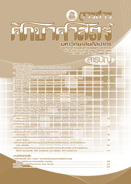แนวทางการส่งเสริมการท่องเที่ยวเชิงวัฒนธรรมในอู่อารยธรรม จังหวัดราชบุรี
Main Article Content
Abstract
ผลการวิจัยพบว่า
1. แรงจูงใจในการท่องเที่ยวเชิงวัฒนธรรมในภาพรวม อยู่ในระดับมาก การเปรียบเทียบค่าเฉลี่ยระหว่างตัวแปรเพศกับแรงจูงใจในการท่องเที่ยวเชิงวัฒนธรรมของนักท่องเที่ยวไม่แตกต่างกัน ส่วนการวิเคราะห์ความแปรปรวนแบบทางเดียวของแรงจูงใจในการท่องเที่ยวเชิงวัฒนธรรมของนักท่องเที่ยว จำแนกตามอายุการศึกษา และอาชีพ แตกต่างกันอย่างมีนัยสำคัญที่ระดับ .05
2. ความคิดเห็นต่อการจัดการท่องเที่ยวเชิงวัฒนธรรมในภาพรวม อยู่ในระดับมาก การเปรียบเทียบค่าเฉลี่ยระหว่างตัวแปรเพศกับความคิดเห็นในการจัดการการท่องเที่ยวเชิงวัฒนธรรมของผู้เกี่ยวข้องกับการท่องเที่ยวแตกต่างกันอย่างมีนัยสำคัญทางสถิติที่ระดับ .05 ส่วนการวิเคราะห์ความแปรปรวนแบบทางเดียวของความคิดเห็นในการจัดการการท่องเที่ยวเชิงวัฒนธรรมของผู้เกี่ยวข้องกับการท่องเที่ยว จำแนกตามอายุ ระยะเวลาในการทำงาน และการศึกษา มีความแตกต่างกันอย่างมีนัยสำคัญที่ระดับ .05
3. แนวทางการส่งเสริมการท่องเที่ยวเชิงวัฒนธรรมประกอบด้วย 2 องค์ประกอบ คือ 1) แหล่งท่องเที่ยว ประกอบด้วยการวิเคราะห์ส่วนขาดในปัญหาและข้อเสนอแนะของผู้เกี่ยวข้อง การพัฒนาแบบพอเพียง(ค่อยเป็นค่อยไป) ตามหลักปรัชญาเศรษฐกิจพอเพียง การมีผู้นำที่เข้มแข็ง เสียสละและจิตสาธารณะ การมีส่วนร่วมของชุมชน ในลักษณะของ ชวร” ได้แก่ ชุมชน วัด โรงเรียน และการพัฒนาแหล่งท่องเที่ยวให้โดดเด่น 2) หน่วยงานภาครัฐประกอบด้วย การสนับสนุนจากภาครัฐ ทั้งความรู้ สิ่งอำนวยความสะดวกในแหล่งท่องเที่ยว การพัฒนาศักยภาพแหล่งท่องเที่ยว การอบรมบุคลากร การประชาสัมพันธ์และการจัดกิจกรรมการท่องเที่ยวอย่างต่อเนื่องเพื่อให้เกิดการพัฒนาที่ยั่งยืน
Promotion Guidelines for Cultural Tourism in the Cradle of Civilization of Ratchaburi Province
This research was aimed to study 1) the motive force level of Thai tourists regarding cultural tourism in cradles of civilization of Ratchaburi Province 2) the opinion of tourist related groups toward this tourism in cradles of civilization of Ratchaburi Province and 3) the guideline of tourism promotion in cradles of civilization of Ratchaburi Province. The research process was based on mixed method of quantitative and qualitative methodologies and divided into two steps as followed:
Starting from the first step of quantitative method, four hundred of Thai tourists and eighty-six of other related persons were systematically chosen as our respondents and these were interviewed with structural questionnaire set no.1 and no.2 respectively. After that in the second step it would be conducted with the qualitative method, the seventeen and twelve key informants were purposively selected for an in-depth interview and invited to joint in the focus group discussion respectively. The quantitative data was statistically analyzed with Statistical Computer Program Package and presented in percentage, mean, standard deviation, outcomes of t-test and F-test method. For the qualitative data it would be then analyzed with the technique of content analysis.
From the results, the motive force of Thai tourists and the opinion of other persons were measured and shown its overall results at much level. When tested with F-test method, the tourists had their age, education and occupation associated with the motive force level significantly at P d”.05. The guideline of tourism promotion was comprised of two components as followed:
The tourist sites: There should have the analysis in its shortages and problems including the recommendations from those concerned. The sites should be gradually developed and this was based on enough to principle of Self-Sufficiency Economy. The leaders should have their strong leadership, sacrifice and public mind. The community involvement should be formulated from the co-working together of three main parts namely Community, Temple and School (CTS).
The government sector: To develop the tourism the capacities in tourism resource, the government offices should support and promote them to have enough knowledge, training for human resources, public relation and advertising, movement of continuous tourism activities for sustainable development.


